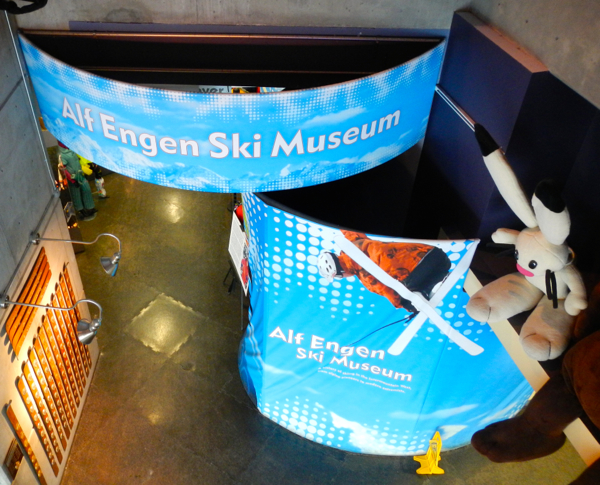Salt Lake Olympic legacy remains on fast track
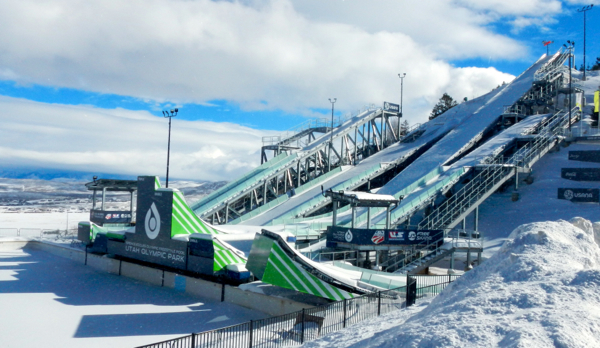
Skiers during the summer come off the jumps, landing in the pool on the left. Photo/Kathryn Reed
Publisher’s note: This is one in a series of stories about Park City, Utah.
By Susan Wood
PARK CITY, Utah – Hurtling down twists and turns at speeds of 80 mph with complete abandon of the danger if the pilot makes a mistake. The centrifugal force to be reckoned with at 4Gs makes a rookie groan, strain to focus, breath heavy and fight back the wind pushing her head down.
I tell myself to sit upright to protect my back, not realizing that after the one minute ride my elbows jammed inside the sled would be the points of my body to have bumps and bruises while gripping the cables seated directly behind the driver, Olympic silver medalist Shauna Rohbock of Orem, Utah.
At the Utah Olympic Park built for the 2002 Salt Lake City Games, I stepped into her vehicle of choice to partake in the second fastest bobsled track in the world. The fastest is at Whistler, British Columbia.
I held on tight to the confidence my four-member bobsled team thrown together with Rohbock at the helm would come out of the open chute surviving and thriving. Jake (the Olympic Park worker in back) told us how rare it is to experience the track without the shade. The sun can wreck the consistency of the track surface in 15 minutes.
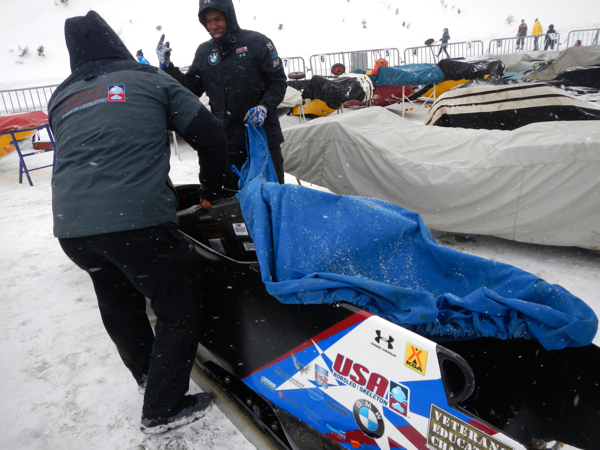
The U.S. bobsled team gets ready for the World Cup event in January. Photo/Kathryn Reed
The U.S. Bobsled and Skeleton Team was in town on this January day for World Cup races along with multiple international teams. Before our run from the top, the chatter on the radios reflected a sense of urgency to keep the practice schedule. The track starts with a 400-foot drop and has 15 curves that make even the fastest roller coaster seem like an E-ticket ride. For $175 a person in winter or $150 in summer, the park provides the public rides on the Comet bobsled that start about a third of the way down from the competition start.
“It’s an experience you don’t have anywhere else,” said Sandy Chio, marketing director for the Utah Olympic Legacy.
The legacy foundation that employs 325 employees (60 year-round) was formed to maintain the Olympic facilities and no host events. Venues include the mega Olympic Park just outside Park City; cross country skiing mecca Soldier Hollow southeast of Deer Valley in Midway; gigantic Olympic Oval in suburban Salt Lake City; Maverik Center for ice hockey in West Valley City; Peaks Ice Arena in Provo; Salt Lake Ice Center in downtown; Utah Jazz Stadium in town; Snowbasin ski area northeast of Salt Lake City; The Ice Sheet at Ogden; Deer Valley Ski Resort; and Park City ski resort.
They are staging grounds for Olympians and wannabes. They also provide entertainment for spectators or those who are enamored with learning about the venues.
In January, Lake Tahoe News visited four of the 11 venues, and met with Park City officials and Olympic Legacy staffers to get a glimpse of what it’s like to host the Games, as well as the work involved before and after. Lake Tahoe hosted the 1960 Winter Olympics at Squaw Valley and the West Shore. For years, a Reno-based group has formed a committee and toyed with the idea of putting on another worldwide event, albeit strategically moving the date every few years to better its chances. The latest quest is for the 2026 Games, of which Salt Lake City has expressed an interest in as well.
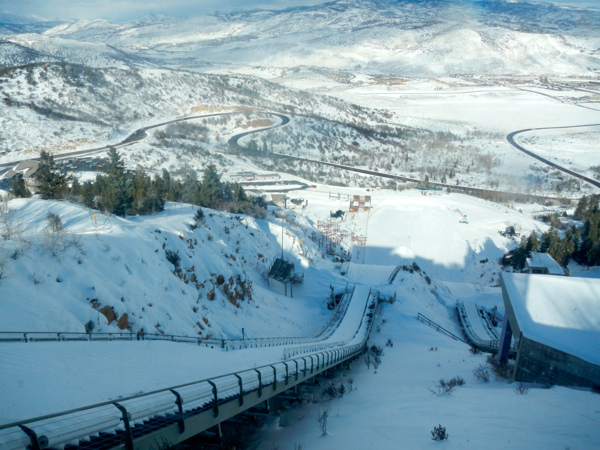
The ski jump has different starting points based on one’s skill level. Photo/Kathryn Reed
A park for all seasons
On an estimated $26.3 million investment, the Utah Olympic Park opened with the bobsled-luge track, and ski museum in 1991, four years before the state received the bid to host the 2002 Games. (Salt Lake also bid on the 1998 Games.) Upon winning the bid, plans were quickly put into place that with a $48 million upgrade the park would add chairlifts, storage buildings, roads, bridges and water lines, replace its 90-meter Nordic ski jump and accommodate a new 120-meter jump ramp.
At first glance, one can see from the steepness at the top this isn’t for the faint of heart.
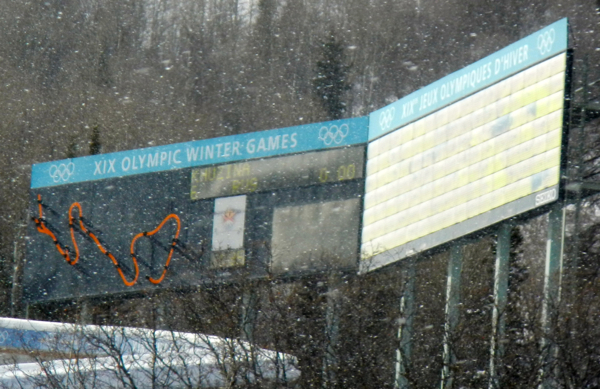
The public may experience a scaled-down version of the Olympic bobsled course. Photo/Kathryn Reed
Tour guide Patrick Rosevear stressed the real slope isn’t as bad as one thinks.
“Every day, we see 12- and 14-year-olds jump. It’s actually the second safest sport,” he insisted, noting jumpers are really only 7 feet in the air despite how it looks on television. Of course, they are flying about 130 feet off a 36-degree ramp at 55mph. If there’s an 8- to 12mph crosswind, jumps are canceled.
At 7,350 feet, Utah Olympic Park has the highest ski jumps in the world.
The freestyle aerial ramps send mogul and hot-dogging skiers 50 feet up in the air. The 40-degree landing is so steep a snowcat must be winched to groom there.
During the summer freestyle aerial skiers train in a 10-foot deep, 1.2 million-gallon swimming pool, which opened last year upon the $1 million donation from Olympic skier Spence Eccles – a philanthropist who also owns the Goldener Hirsch hotel near Deer Valley.
The freestyle venue hosts many after-school programs for children. The park itself boasts more than 400,000 visitors.
Many are fascinated with the bobsled-luge track maintained by a $15,000 cooling system serving 100 miles of pipes. Rosevear noted that even though a participant sits up instead of lying down like the skeleton (considered one of the easiest and safest “by a huge margin”) the luge represents one of the most dangerous sports.
“It’s the steering. If you come into a turn and you miss by one inch at 91 mph, it can eject you off the sled,” the guide said as a hush came over the tour van. In the luge, the riders wear spikes on their gloves to paddle – not to stop.
For a more relaxed experience, guests may peruse the two museums at the park. One is dedicated to the history of skiing and the other to the 2002 Olympic Games. A whole wall displays Park City’s Olympic giant slalom racer Ted Ligety. Another exhibit features Olympic bobsledder Steve Holcomb, who brought home a medal in the last Winter Olympics in Sochi, Russia.
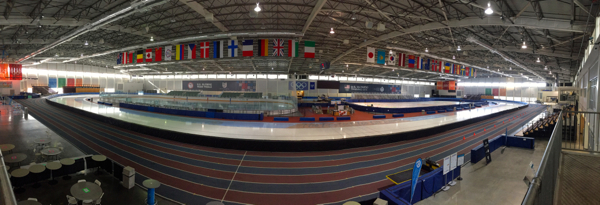
The Oval is used by the U.S. Olympic team to train, but is open to residents as well. Photo/Kathryn Reed
Making the skate world go round
For those who like to get a quad burn on two blades, the Utah Olympic Oval has much to offer for the Olympian, aspiring youth or spectator hoping to catch a glimpse at the next Apollo Ono. The Olympian showed up for an exhibition event last November as part of the Oval’s quest to offer events that bring in visitors. There’s also “cosmic curling” for others wanting to figure out this mysterious sport.
The Oval was built on a 5-acre footprint in Kearns outside Salt Lake City in 1994, a year before Utah received the bid. Olympic revenues were used to cover the up to 4,000-seat oval and build an ice sheet in the center of the track. This sheet is now deemed “the fastest ice on Earth,” Oval Operations Manager Todd Porter told Lake Tahoe News on a special tour. It’s also the highest, at an elevation of 4,675 feet.

Todd Porter, who oversees the Olympic Oval, stands between the running track and ice for racing. Photo/Kathryn Reed
Porter talks poetically, albeit with a chemist’s know-how, about the Oval’s massive central cooling system, which seems like it could span the globe with pipes. Depending on the event, the ice changes consistency. It’s this control that attracts Olympians such as Jessica Smith-Kooreman, who trains in Salt Lake. She owns four short-track speed skating World Cup titles and came in fourth in 2014 at the Sochi Winter Olympics.
“I moved here for the facility itself. It’s the best and safest ice because it can be controlled. In the Olympic year, we had the ice switched to what is in Russia. Most places can’t do that. The Oval is good for taking care of its athletes,” she told Lake Tahoe News on a break from training. “You’re able to push your limits every day.”
The Oval schedules a host of “learn-to” programs that may spur the next Olympian. It can rent 1,000 skates, but all of the efforts seemed futile in the beginning, Porter admitted.
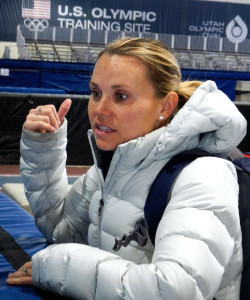
Olympian Jessica Smith-Kooreman raves about the ability to change the consistency of ice at the oval. Photo/Kathryn Reed
“At first, marketing to people around here was tough because they thought it wasn’t for them,” he said.
But getting the word out is paying off. Porter reported a record week of attendance between the Christmas and New Year’s holidays, with 20,000 people taking in the large facility the size of four football fields. The place houses 10 locker rooms and a tunnel taking visitors from one side to the other. The concessions are managed in house.
Even the weight room is an experience, with television cameras set up for trainers to evaluate their athletes’ performances.
It’s the Europeans who appear to appreciate the facility the most, making it a stop on their U.S. vacation — with Netherlands television blasting skating events on site.
“To them, it’s like (visiting) Yankee Stadium,” Porter quipped.
The Oval loses about a $1 million year, but “that’s the key part of where the (financial) endowment comes in,” Porter stressed.
Still, Porter is always thinking of new ways to attract revenue and save money. The Oval has adapted a solar program designed to save the facility $2,000 a month in energy efficiency.
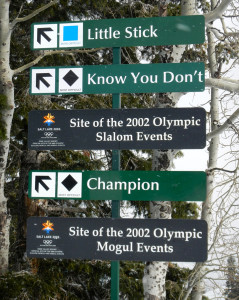
Deer Valley lets skiers know where the Olympic events were. Photo/Kathryn Reed
Patience, perseverance to put on the Games
It takes good fortune, luck, money and will, according to Park City officials in describing handling the Olympics. After all, the region had tried a handful of times.
“The first challenge was no one believed we could actually do it. At the start, we thought it was a joke,” former city staffer Myles Rodeman, one of the architects of the 2002 Games, told Lake Tahoe News.
Rodeman, who was involved with the effort for 13 years, recalled the effort like it was yesterday. Ski racer and then Mayor Brad Olch walked in his office asked, “What do you think of us going in with Salt Lake for the Olympics?” Thus began a transformation of the ski town that was hard to imagine at the time.
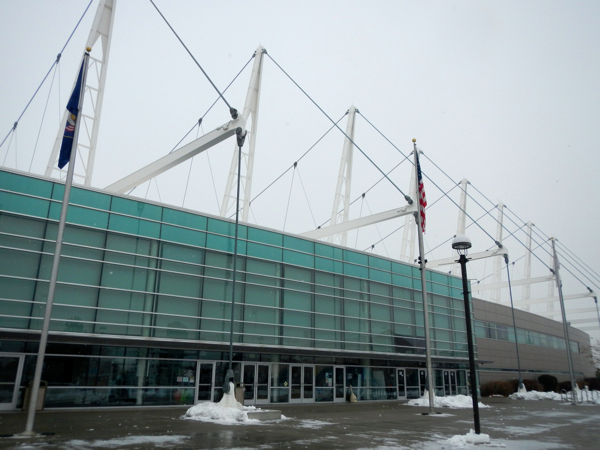
The Olympic Oval is located a ways from Park City and Salt Lake City. Photo/Kathryn Reed
This was the 1980s when the ski industry was clawing out of a dismal period, so a boost for the economy seemed like a promising idea if it were to pay off.
Although now it takes at least $20 million to justify the investment of actually staging the Games, the $7 million raised at that time, mostly by private companies, for the bid was a lot of money. A master plan was devised, the local Rotary became a lobbying partner, and the Ski Utah organization discussed who would be best suited to host the ski events. Park City and Deer Valley appeared prime as host resorts – but not without a little power struggle and politics.
“We knew other resorts up the (Big and Little Cottonwood) canyons would be most difficult to serve in terms of transportation and avalanche conditions,” Rodeman said.
The Olympic Oval in Salt Lake seemed a bit problematic with its location being so far out.
There were so many considerations in hosting the Olympics.
Take transportation. During the Games, the Utah Department of Transportation forced truckers to re-route on Interstate 80.
Take parking. It’s no easy task, but up to 3,500 spaces were created in parking lots outside the downtown area of Park City.
“It was an incredible effort. You could not drive a car here,” Rodeman said.

This style of sign is a signature for the Salt Lake Games that is seen at all the legacy venues. Photo/Kathryn Reed
Take the swag. During the bidding process, a “necessary” amount of generous “gifts” are traditionally given to Olympic Committee board members. In these staged events, one might see an assortment of items that exemplify a host city’s profile. At one event, Salt Lake City brought salt-water taffy, pins and hats but lost the bid. Nagano, Japan, won the 1998 bid using violins, computers and cars. Salt Lake won with rifles from Browning, a local company, Rodeman noted. The stakes for hosting appear high.
“Right there, I thought we lost (the bid),” he said. “In those days, you have to get all the (committee) members to support you.”
These days, regulations surround gifting internationally. Much of this came out of the 2002 Games.
Take hometown rules. Utah suspended all drinking laws for the 25 days surrounding the Olympics.
Take housing – which takes creativity as well. The athlete housing now serves as student dorms at the University of Utah.
Take security. The 9/11 terrorist attacks had occurred five months prior. The celebrations were staged in downtown Park City, making city officials and organizers nervous with the feds slow in coming.
“We needed security, but we didn’t want to look like we were armed for the cameras,” said Rodeman, who was in Atlanta on a scouting tour during the 1996 Summer Games when the bomb exploded.
City officials and Olympic organizers toured five Olympic towns to see how they fared in the process – the Georgia city, Nagano, Sydney, Lillehammer and Calgary.
Olch, who served as Park City mayor for 12 years during the Olympic endeavor, recalled how the 1988 Winter Olympics in Calgary were considered as netting a less-than-desirable “Olympic performance” before and after the Games.
So Salt Lake City decided to plan to build facilities under the supervision of the Salt Lake City Olympic Committee ahead of schedule.
“We really stepped up there,” Olch told Lake Tahoe News. “We had the experience (with ski venues), and the community got behind the sports venues and the whole Olympic thing.”
The 40-year Park City resident admitted to spending “a lot of time talking to a lot of people convincing them it’s a good thing,” and in the end, “it worked out incredibly well.” Olch insisted he wouldn’t live anywhere else.
“Sure, putting on the Games is always challenging, but it exceeded all our expectations in how well it went and with what it did for our community – the list is quite long,” he said.
Park City Public Affairs Manager Phyllis Robinson agreed.
The city put out a communitywide visioning process recently and asked its residents what they were most proud of Park City. The Olympics were mentioned often.
“I remember standing on Main Street. We were having this great party. (Comedian David) Letterman was at the bottom of the hill, and I thought this is something really special. I thought: ‘Holy crap, we pulled this off.’ With businesses, everybody put something in the pot to make this happen.”
Her colleague, Economic Development Manager Jonathan Weidenhamer, said it’s possible in the Lake Tahoe region. He visited Tahoe last year during a South Shore tourism forum on economic and community revitalization and turned it into a tutorial.
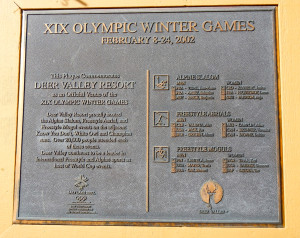
Deer Valley immortalizes those who medaled in the events at the ski resort. Photo/Kathryn Reed
He pledged the South Shore would find a way to get the loop road project through if the region gets the Olympic Games.
“When you have the mission to get the Olympics, you can move mountains,” he said.
Park City taxpayers faced a slew of bonds and tax measures, while a $70 million endowment kicked off the Utah Olympic Legacy foundation – the driving force behind maintaining the benefit of hosting the Olympics.
The 2002 Games cost $1.6 billion, with a little more than half coming from the state. It ended up netting $100 million. The profit went into the foundation coffers to run the Olympic facilities, Foundation President Colin Hilton told Lake Tahoe News.
While it was an overall winner, Park City businesses lost money during the two-week period. This was expected. The entire Main Street was closed to vehicles the entire time.
“The sole focus is on our continued legacy. We’re not caught up in living in the past. We’re living the legacy with our people and programs, contributing to the Olympic movement,” Hilton said.
Already, the Salt Lake-Park City region hosts many World Cup events and makes the programs “the fabric of the community.”
Hilton, one of the early architects of getting the Games to the area, was also more than pleased with the outcome. He is thrilled a new generation is carrying on the tradition – from the athletes (with 50 local Olympians living in the region) to those working behind the scenes at city offices who may have worked in other jobs at the time but stepped up to support the effort.
Assistant City Manager Matt Dias worked in a Park City restaurant during the 2002 Games.
“The Olympics are an incredibly important part of our community’s history, story and legacy. We take great pride in all of the hard work done by various community members and stakeholders that made the Games such a tremendous success,” he said. “Unlike other Games, the vast majority of the 2002 venues and infrastructure was either repurposed and returned to their prior uses and/or built new and now house vibrant and robust programs to ensure self-sustainability.”
Dias singled out the Utah Olympic Park for its off-season programs for providing a backdrop for events, boosting the local economy by filling restaurants and hotels and attracting teams to the area.
